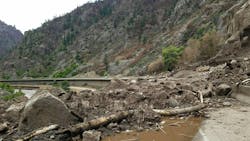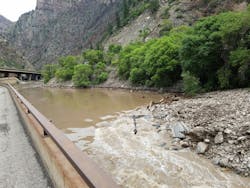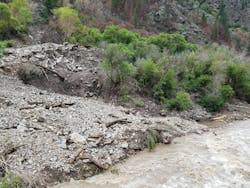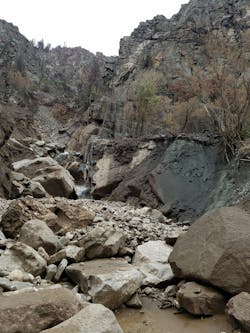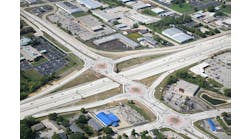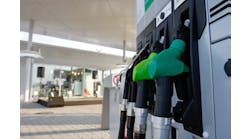By Matt Huddleston, Contributing Author
Climate change affects how owners and agencies look at the future of transportation. It also changes the planning paradigm that alters how asset management is performed.
Agencies have come to understand that adapting to climate change and repairing broken assets will increase costs. While that is true, the good news is that there are proactive, money-saving best practices owners can follow to increase the life of assets and improve safety for the traveling public.
The federal government requires the Department of Defense (and non-defense agencies) to prepare master plans, design, and construction projects to incorporate future climate projection data.
Code, state, and local regulatory rule writers are starting to require climate change incorporation as well, and the trend will only continue. Not only do these codes, laws, and regulations protect and prolong the lives of key transportation assets, but anticipating climate change will also help transportation agencies to improve safety.
Eyes glaze over when huge climate change costs are presented to transportation officials. The numbers can be overwhelming, but there are many ways that smaller investments can have big impacts. Here are the key winning climate change strategies.
Vulnerable Zones and Assets
Today’s nationwide climate data is not just historical, which no longer is adequate, but is based on models that factor in future conditions.
Climate projection data is available out to 2100 and is based on sophisticated climate models that factor in location, greenhouse gas emissions levels, global population and more. These climate models can be narrowed down to a local scale with data for a patchwork of three-mile grids.
Resilient Analytics, a Stanley Consultants company, analyzed climate change projections that would affect more than 2,500 municipalities in Pennsylvania. The objective was to reflect the diverse conditions and associated cost considerations for adaptation across the state.
While a major portion of the $15 billion in cumulative climate change costs through 2060 were projected for major cities, a statewide risk map showed that all state transportation assets are likely to be affected by climate change, but at different levels. Roads accounted for $6.2 billion, while bridges were projected to cost $315 million.
In another study, Resilient Analytics considered the cost of adapting transportation infrastructure to climate change across New York, which required in-depth analysis of the state’s diverse conditions.
Adaptation costs were generated for different climate scenarios for roads, rail, and bridges statewide. Through anticipating climate change and targeting specific at-risk assets, average savings of 50% were projected for proactive engineering and maintenance approaches when compared to reactive approaches.
Aggressively Maintain Roads
Climate change stresses — namely higher temperatures, more precipitation, and greater freeze-thaw frequency in formerly colder climates — lead to an increased rate of degradation of road surfaces in the form of rutting, cracking, and erosion.
At a minimum, new maintenance practices that include more aggressive temporary resurfacing, patching, and crack filling will be required to reach the asset’s intended lifespan.
The winning strategy is to redesign the binder that holds the asphalt aggregate together for future conditions, eliminating the need for increased maintenance frequency. This proactive move will save money over the life of the asset.
If newer maintenance standards are not followed, the lifespan is reduced, and failure could occur earlier than expected. That would create safety hazards.
The Environmental Protection Agency (EPA) commissioned a national study of roads and bridges, urban drainage, and coastal property called Climate Change Impacts and Risk Analysis (CIRA). In relation to roads and bridges, it quantified asset lifespan degradation and the associated cost of increased maintenance requirements.
The greatest impacts are projected to occur in the Great Plains region, where costs are mainly due to erosion of unpaved roads associated with increased precipitation. Costs associated with the use of different pavement binders to avoid cracking of paved roads are also high, particularly in America’s Midwest and Southeast regions.
They increase over time in all regions due to the projected rise in temperature.
The benefits of proactive asset management accrue over time. Nationwide, the study predicted that owners could avoid more than $7 billion in climate adaptation costs by proactively preparing their assets for climate change by 2100.
These cost savings depend on the climate model, but even preparing for the mildest climate change scenario could save transportation owners $4 billion.
Protecting the Road Base
In the summer of 2021, the Grizzly Creek Fire burned through the vital east-west nationwide arterial of Interstate 70 at Glenwood Canyon in the western Colorado Rocky Mountains.
Soon after the fire, unusually heavy rains caused flooding, mudslides, and roadway bed washout that closed a major national interstate for two weeks.
It also trapped 100 people in their cars and incurred $116 million in repair cost. Economic impact from supply chain disruption was also observed as 4,900 trucks a day had to be rerouted.
This fire, followed by roadbed washout sequence, has occurred countless times in the west during the past decade, affecting paved and unpaved roads.
The winning strategy for road base erosion is to improve and strengthen roadbeds at the replacement stage, or at the end of their useful lives.
Storm drainage and vegetation improvements should be considered where possible in advance of extreme weather-related events.
In the case of steep, rocky canyons, Colorado officials said that some vegetation on less vertical surfaces would help, and the state has increased its rock and slide fall measures in Glenwood Canyon, but that mitigation is difficult on the steepest slopes.
However, in most locations nationwide, roadbed improvements can be made, particularly upon replacement.
Bridge Pier Scour Risk
Most bridge failures are caused by scour, which is where swiftly moving water removes sediment from around bridge structural supports, weakening or destroying its foundations.
Frequent flooding and long-term river flow changes caused by climate change are expected to increase the amount of bridge scour, further stressing the aging U.S. bridge inventory.
Winning measures for protecting bridges from increased river flows due to flooding or higher river flows include adding riprap, shot rock, rock armor or rubble and adding concrete to support pillars in contact with water.
The EPA commissioned Resilient Analytics and its team of structural, hydraulic and construction engineers to calculate adaptation costs for the 250,000 bridges that crossed waterways in the U.S.
Engineers found that more than 190,000 of the bridges will be vulnerable to damages unless the global greenhouse gas scenario changes, and those bridges could benefit from defensive, adaptation measures, saving $2-$4.2 billion from 2010 to 2050 and $10- to $15 billion from the 2051 to 2100 period (3% annual discount).
The model’s calculations worked as follows: If there is less than a 20% increase in flow, then no cost is incurred. Instead, it is assumed that the bridge is designed to handle that amount of flow increase.
For a flow increase of more than 20% but less than roughly 60%, riprap installation is costed as the adaptation. For a flow increase of more than 100%, then the adaptation cost is for strengthening abutments and piers with concrete.
The model also considers whether the river has a sandy or rock bottom. Sandy bottoms can't withstand as much flow increase, so thresholds are lower than in a rock bottom.
Geographical Risks
Climate stresses like the effects of permafrost thaw in Alaska or floods in the Great Plains, represent more than just normal wear and tear on roads and bridges.
Models have been created to analyze how Alaska might respond to degradation of transportation assets, including early replacement, change of design, and changing building codes. The models allowed officials to determine appropriate response actions as part of long-term planning.
The cost to repair damage from climate change to roads was estimated at up to $3.1 billion. That cost could be lowered to $870 million if adaptative measures are taken.
The winning tactic here is to identify roads and bridges at risk if permafrost melts and to develop new engineering guidelines to protect road and bridge foundations from liquified soils.
Base-layer modifications and installing thermosyphon are several possible adaptation strategies.
As permafrost thaws, you can install adaptation in the form of embankments and thermosiphons, which let heat escape from the road to slow the thawing.
In areas with a mixture of ice mixed with rock and soil, voids develop as ground ice melts. Adaptation for this is filling and repaving. This creates a stronger subbase.
In the Great Plains, storm runoff overburdens drainage systems, disrupting transportation systems and damaging assets.
The EPA CIRA study estimated that without greenhouse gas reductions, the 50-year, 24-hour storm baseline scenario will cost major cities $1-$12 billion, and mitigation measures could save up to half that cost.
Adaptive actions focus on the use of best management practices to limit the quantity of runoff entering stormwater systems. For road flooding, the adaptation involves increased diameter culverts and drainage systems.
Rising Sea Levels
America’s coastlines are increasingly at risk of inundation by sea level rise and increased storm surge.
The Resilient Analytics team studied a group of communities in Florida and found that storm surge could lead to 70% inundation by mid-century. With transportation assets at risk, the islands will need to enhance protective barriers, potentially raise the access roads to bridges and develop enhanced designs for emergency evacuation routes at a cost of $10 million.
During a coastline study, Resilient Analytics estimated that 53,000 miles of protective barriers will be required to protect infrastructure by 2040 — at a cost of $400 billion. There are other attractive options, such as establishing natural shorelines and wetlands.
Climate adaptation measures lower the economic impact of long-term delays stemming from slower speeds associated with damaged road surfaces. There are also short-term delay costs because maintenance activity leads to road closures.
Worker Safety
As maintenance requirements increase, so do the risks to workers who are forced to work in more extreme weather conditions.
Climate change is having a significant impact on construction schedules. Extreme heat, a leading cause of weather-related deaths in the U.S., is reducing productivity levels as workers require longer and more frequent breaks during extreme heat events.
Extreme precipitation events are causing delays as sites are temporarily closed due to standing water. This is financially impacting the industry as delays directly translate to increased costs.
According to government data, exposure to excessive environmental heat stress killed 783 U.S. workers and seriously injured 69,374 workers from 1992 through 2016 across all industries. Additionally, numerous studies provide evidence that extreme heat increases the number of workplace accidents. Heat waves increase workers’ compensation claims in outdoor industries by 6.2%.
Taking adaptive measures in advance can significantly lower work safety and productivity impacts. RB
Matt Huddleston, P.E., is a senior climate resilience consultant at Resilient Analytics, a Stanley Consultants company. He can be reached at [email protected].
